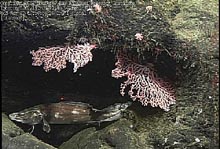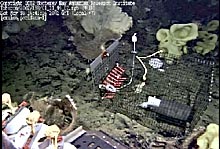
A cusk eel takes refuge in a crevice, under an umbrella of gorgonian corals. Click image for larger view.
Assessing Mobile Animal Communities on Davidson Seamount
May 21, 2002
Mario Tamburri
Science Team Leader and Co-Prinicipal Investigator
Univ. of MD Center for Environmental Science
![]() Amazing video from the depths of Davidson Seamount. (mp4, 3.9 MB)
Amazing video from the depths of Davidson Seamount. (mp4, 3.9 MB)
One of the main goals of this expedition is to characterize the biological communities that live on and near the Davidson Seamount. In addition to providing a better basic understanding of seamount communities and their biological/ecological processes, this work will provide critical information on the susceptibility of this unique environment to human activities.
We are using quantitative video transect with a remotely operated vehicle (ROV) to conduct most of our surveys. ROVs allow rapid and detailed observations of benthic invertebrates, bottom fishes, and their habitats in environments that are remote and difficult to sample with traditional techniques such as bottom trawls and grabs. However, comprehensive assessments and complete identification of fast moving or small animals from ROV videos can often be difficult and in some cases is impossible. Visual surveys can also miss organisms that are cryptic, occupying hidden microhabitats, or avoid camera and lighting systems. Therefore, we are complementing our ROV surveys with baited traps to identify those fishes and invertebrates that are attracted to bait but are not seen by the ROV.

At a depth of 1,725 m., the team made an astounding observation, they spotted a halosaur. Very little is known about this fish, which had previously been sighted only once. Click image to launch video. (QuickTime, 830k)
In areas we surveyed by video, we have also set specially designed baited trap-in-trap systems. The large outer box traps will catch fish, while minnow traps placed inside will catch small organisms like amphipods. This technique will not only give us a more complete characterization of the organisms living on the Davidson Seamount, but will also be a first step towards comprehensive fish stock assessments.
Deep-water fisheries have overexploited various species that congregate at seamounts worldwide for many years. The classic example is the orange roughy (Hoplostethus atlanticus), found off the coast of Australia and New Zealand. The life history of the orange roughy is similar to that of many deep-sea fishes; they are long-lived, have low reproductive output, and are group-synchronous spawners. These traits, combined with the fact that these fishes are targeted by trawlers while in the spawning aggregations, has resulted in a collapse of orange roughy populations in many areas.

The ROV Tiburon places a fish trap along the Davidson Seamount ridge crest. Click image for larger view.
The impacts of trawling and dredging also go far beyond the removal of target species. Many fishing practices tend to snare large numbers of non-commercial animals as bycatch, and can severely damage benthic habitats and organisms by scraping (equivalent to clearcutting) the seafloor. This is important because many organisms inhabiting seamounts are endemic – meaning that there are no nearby populations that can rapidly re-colonize impacted areas.
From the few surveys in other regions of the world, it appears that there are hundreds of animals that are found exclusively on seamounts. The highly localized distribution of many seamount species has profound implications for their conservation. Seamount communities are restricted to fixed habitats, and many non-commercial species are also very long lived (on the order of 100 years or more) with limited dispersal and recruitment between seamounts. Combined, these factors results in extreme vulnerability to the impacts of fishing and the uncertainty of recovery from practices like trawling. Because bottom trawling does not yet occur on the Davidson Seamount, we have a unique opportunity to study this region in a relatively undisturbed state. And if our studies demonstrate that there are indeed unique assemblages of animals associated with the Davidson Seamount, this information can be used to develop management strategies that will ensure the ongoing health and well being of this unique resource.
Sign up for the Ocean Explorer E-mail Update List.















